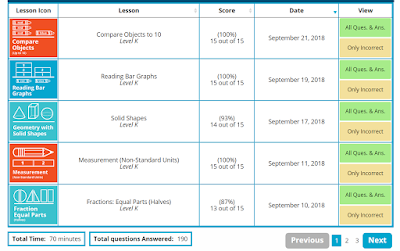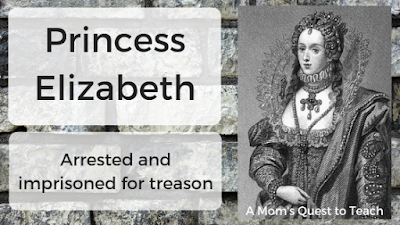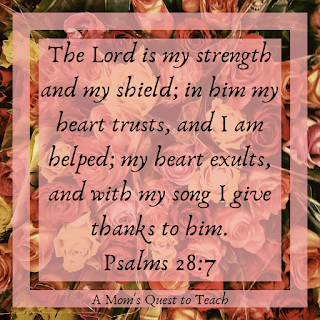I am very grateful that God listens to us with His eyes open and ears ready to hear our prayers. Even if we are unfaithful, God still helps us when we turn back to Him.
A Mom's Quest to Teach is a regular column covering elements of teaching and learning (with an eye towards homeschooling), parenting, crafting, and all of the discoveries, joys, and daily roller coaster rides that occur while being a mom.
Sunday, September 30, 2018
Friday, September 28, 2018
It was a dark and bleak morning...Writing Prompts for October
Do your older children and teens struggle with writing fiction? I remember when I was in high school, we subscribed to a few magazines that would provide the readers with photographs and writing prompts for short story contests. I found these to be influential in my journey towards becoming a writer.
So take a look at one of the images...or print out the writing prompts for October and start writing your own story or share with your children so they can go on their own writing adventure.
Happy Writing!
October Writing Prompts Worksheet
Thursday, September 27, 2018
T is for Tower of London (Blogging through the Alphabet)
One of my favorite memories of my trip to England in 1997 was visiting the Tower of London. Seeing the ravens, the White Tower, and the crown jewels was a highlight of the trip. What images come to mind when you hear someone talking about the Tower of London? Many think of a prison – even though it was a royal residence, a barracks, an armory, a zoo, and a tourist destination. It was during the 16th and 17th centuries that the Tower of London reached its height as a place of imprisonment.
During the Middle Ages, high-ranking prisoners might be kept in a secure part of the royal lodgings or given other lodgings while privileged to such activities such as walking around the Tower grounds, receiving visitors, or having their personal possessions at their disposal. Conditions were really not bad – in fact they were much better than the prisoners faced in Newgate or Fleet prison. In general, there were two forms of confinement at the Tower:
- Close: Where a prisoner would be secured in their own quarters with strict security or guards to watch them.
- Open: A prisoner would be confined to the castle precincts and allowed access to various locations – with or without guards.
When discussing the Tower of London being used as a prison, images of torture and execution might also be brought to mind. However, there were only 48 cases of torture from 1540 to 1640. There were three main methods used for torture when it was ordered by the Privy Council. These methods include:
- The Rack
- "Scavenger's daughter" or "Skeffington's Gyves"
- Manacles
There were also only seven executions that took place within the Tower's walls. Most took place at Tyburn or on Tower Hill. So while torture and executions certainly happened there, the Tower of London is not really an infamous place of torture, execution, and death as some histories and tales would suggest.
Famous Prisoners
There are have been many famous prisoners housed in the Tower of London including:
- Anne Boleyn
- Sir Thomas More
- Princess Elizabeth (who would later become Queen Elizabeth I)
- Lady Jane Grey the Nine Days Queen
- Sir Walter Raleigh
- Members of the Dudley Family
- Princes in the Tower – Prince Edward V and Prince Richard
- Guy Fawkes
- Rudolf Hess (deputy leader of Nazi Party)
- Josef Jakobs (German spy during WWII)
Sir Thomas More
More was a lawyer, author, and a statesmen who had the misfortune of crossing King Henry VIII. During the period when Henry VIII was looking for a way to separate from his first wife, Catherine of Aragon, he broke away from the Roman Catholic Church and the Pope in Rome. Henry VIII then declared himself as the Supreme Head of the English Church and required his citizens to swear an oath to him as such. Sir Thomas More resigned his position as Lord Chancellorship in hopes he could avoid taking the oath. As Henry VIII needed (and wanted) More's recognition as a learned man, he arrested and imprisoned More in the Bell Tower. More was one of the higher ranking members of society who faced hardships in the Tower. For a time he was forbidden to write and not allowed his books. Eventually he was found guilty and executed at Tower Hill.
Anne Boleyn
The very wife that King Henry VIII married after separating from the Roman Catholic Church was eventually arrested and imprisoned in the Tower of London. She was tried in the Tower itself and was sentenced to death on the Tower Green. Anne Boleyn was one of the few individuals to have a special executioner, a swordsman, be brought in from France.
Lady Jane Grey – Nine Days Queen
While Edward VI, son of Henry VIII and Jane Seymour, was ruling England, John Dudley (first Duke of Northumberland and Earl of Warwick) ruled as Lord Protector from 1550 until 1553. During this time he pushed Lady Jane Grey (granddaughter of Henry VIII's sister Mary and Charles Brandon – Duke of Suffolk) to marry his own fourth son – Lord Guildford Dudley. At the insistence of John Dudley, King Edward VI wrote a will in which he names his two half-sisters as illegitimate removing them from the line of succession. The throne was left to Lady Jane Grey – John Dudley hoped to be able to control her and continue to rule England.
On July 9, 1553, after the death of Edward VI at age 15, Lady Jane Grey was told she was the Queen and was taken to the Tower. Not as a prisoner but as a queen. During this brief time, Mary Tudor (the Catholic daughter of Henry VIII and Catherine of Aragon) rallied support to her cause. The people of England did not want John Dudley to remain as Lord Protector and support Mary as the future queen. John Dudley was arrested and Lady Jane was moved from the royal apartments to be confined in the Gentlemen Gaoler's Apartments. Dudley was confined with his five sons (including Lady Jane's husband) in the Beauchamp Tower. It is in this Tower that one can see inscriptions or graffiti from the Dudley family on the walls.
Lady Jane was tried and found guilty of treason. Lady Jane was one of the lucky prisoners who was not on close confinement during her imprisonment. In fact, she could walk around the gardens and around Tower Hill with an escort. She and her husband were both sentenced to death. Her father-in-law, John Dudley, was also sentenced to death.
Princess Elizabeth
During the reign of Mary I, many individuals were thought to be trying to overthrow the Catholic Monarch. Queen Mary I even had her half-sister, Elizabeth, arrested. She was arrested for treason (being implicated in Sir Thomas Wyatt's rebellion) and brought to the Tower of London through the Traitor's Gate. While confined in the royal lodgings she etched on the window:
"much suspected of me; nothing proved can be."
There was never any evidence found to connect her with the rebellion by Sir Thomas Wyatt. Eventually, Elizabeth was released but kept under watch until the death of her sister. That is when Elizabeth ascended to the throne herself.
In conclusion, the Tower of London is one that still haunts the history of England today as so many famous individuals have walked the grounds. Does it deserve to be remembered more so as a prison and place of torture and execution than the other 'jobs' which it held? Probably not. But it is one of the interesting parts of its history.
Resources and Images
Photo used for Title Image from © Bufo_bufo | Stock Free Images
Other images from wpclipart.com and Canva.com
Other images from wpclipart.com and Canva.com
Tuesday, September 25, 2018
Setting the Mood with Edgar Allan Poe
What draws you into a story?
 So who is the Lady Ligeia? If she is important enough to write about, why can't our author remember more about their history together?
So who is the Lady Ligeia? If she is important enough to write about, why can't our author remember more about their history together?One of the things that often draws a reader into a story, poem, or novel is the opening paragraph. Many individuals might read the first few sentences or paragraphs of a written work and decide it is or is not right for them. Well, what if we all had the same way with words that Edgar Allan Poe had in writing? For me, reading the first few lines of a Poe story or poem invokes wonderful imagery, people, places, and events that invite me to learn more.
In this post, I will share a few of my favorite opening sentences from Poe that set the mood for a thrilling Halloween season.
What did the author ponder about? Why was he up so late when he was already tired? And who taught the raven to speak in the first place?
One of my favorite stories is that of The Tell-Tale Heart...perhaps it is because of a fantastic Park Ranger who brought the story to life while on a tour of the Edgar Allan Poe National Historic Site in Philadelphia. I remember reading it for the first time with a dictionary at hand as I was in elementary school and so many of the words Poe used seemed so difficult but so important to learn. Have you heard the tale of this madman?
I love the way The Fall of the House of Usher begins. I feel like I am riding a horse alongside the narrator. Even if it is a bright sunny day, I can sense the darkness and coolness of a fall day when I read this story.
Do you have a favorite author who intrigues you from the very first page of their work?
Resources
Image of Pallas-Athene
Image of House
Monday, September 24, 2018
Adding up to a Fun Way to Practice Math: A Review of I Know it
What is I Know It
This "comprehensive, interactive math practice site" is geared towards children in Kindergarten to fifth grade. It is great because it can be used by homeschooling families (like us) or by children who attend public or private school. In both cases, it is designed to assist students with independent practice "allowing them to work at their own level and pace towards mastery of concepts and skills aligned with common core."
I Know It is from the same team that built and operates SuperTeacherWorksheets.com. You can also use I Know It on a number of different platforms or devices such as laptops, Chromebooks, iPads, and desktop computers. Feature access might be limited if used on a mobile phone. Questions can also be read aloud to your children or student(s).
The program is customizable, which makes it easy to monitor individual progress with reports and emails to help you track where your child or student is in the program. The concepts are sorted by grade level, which makes it easy to find the skills your child might need to work on.
There are three different types of memberships one can purchase:
- Home/Family Membership (allows one family account for one parent & up to 4 children)
- Single Teacher Membership (allows one teacher account and up to 30 student accounts)
- School or District Membership (allows any number of teacher/student accounts to be set based upon needs of school)
The Home/Family Membership, which we are using, has one family login and only costs $90 per year. If you have more than four children, there is a small fee of $8 for each additional child.
Here is a brief overview of the topics covered in Kindergarten. Those our children have used at the time I wrote this review are blue:
- Numbers & Counting & Place Value
- Counting Objects to 5
- Counting Objects to 10
- Place Value (Up to 20)
- And more!
- Geometry & Shapes
- Flat Shapes
- Classifying Objects by Shape
- And more!
- Addition
- Addition to 5
- Basic Addition to 10
- Adding Zero within 10
- And more!
- Comparing Numbers
- Compare Objects to 5
- Compare Digits to 5
- Compare Objects to 10
- Compare Digits to 10
- Subtraction
- Basic Subtraction
- Subtraction Drills
- And more!
- Measurement
- Longer/Taller and Shorter
- Non-standard Units
- Heavier/Lighter
- Hot/Cold
- Time & Money
- Coin Identification and Values (USA)
- Coin Identification and Values (Canadian)
- Counting Different Denominations (Both USA & Canadian)
- Telling Time to the Hour
- Addition & Subtraction Mixed
- Addition and Subtraction to 5
- Adding and Subtracting Zero
- And more!
- Classifying Objects
- Patterns
- Graphing
- Reading Bar Graphs

Topics in other grades include:
- Numbers & Place Value
- Multiplication
- Division
- Basic Algebra
- Fractions
- Geometry
- Word Problems
- And more!
My dashboard as the parent lists more information and tabs than that of our children. For example, I can access my account, my children's accounts, the assignments for both of the children, and the progress for both of my children. Our children's accounts only provide them access with their homepage (which has their assignments and the topics available to practice), settings (if they wish to change the animation), and their own individual progress.
How We Are Using I Know It
As our five-year-old son is not using a formal math curriculum yet, we are using I Know It as a way to introduce and reinforce concepts with him. I set up several assignments I would like him to complete, but I have given him the freedom to select the kindergarten activities that he would like to do.
Our son has completed a number of lessons ranging from Counting Objects to 10 to Fractions: Equal Parts (Halves). In general, I think he has had more success than he thought he would as he tried the different topics.
Each activity seems to have a combination of typing and selecting the right answer. With each correct answer, there is an animated figure that celebrates the correct answer.
In the case of our three-year-old daughter, she is discovering how to use the laptop while she is reviewing her numbers. She has been completing mostly the Counting Objects to 10 and Flat Shapes lessons from the Kindergarten level. As is typical of most smaller children, she has started a number of assignments and not completed them. But that is okay...she is enjoying working with I Know It and learning more about numbers.
We receive a progress report via email so we know what our children are working on during the week. There are also progress reports online available to the student so they can review the problems. The report is broken down by lesson.
 |
| Report via email |
 |
| Progress report available for our son's viewing on his own account |
Recommendations
Even though the site mentions common core, I haven't found anything overtly pushing the idea of common core. If you click on the 'cc' next to lesson topic, it will bring up the common core standards associated with the questions.
 |
| When clicking on the 'cc' next to the lesson, you will find more detailed common core standards. |
I like that there are a variety of questions to help children master the skills along with cute graphics and animations that our son enjoys. The lessons are short which are great for a quick review of a topic. There are also a number of places from the Q & A to the Help Files, where you can look for answers to your questions about the site. I would recommend this for those interested in providing additional review for their children in mathematics whether your children are homeschooled or attend public/private school.
To learn more about I Know It, please visit the following:
To read more reviews, please visit the Homeschool Review Crew!
Sunday, September 23, 2018
Journaling through the Bible: Daniel
This post contains affiliate links. For more information please see my Terms of Use and Disclosure Policy page. Thank you.
I read the Book of Daniel this week and shared some of the stories with our children via Veggie Tales and 66 Books One Story: A Guide to Every Book of the Bible by Paul Reynolds.
I tried my hand a few techniques from my Bible Journaling book.
Thursday, September 20, 2018
S is for the Spanish-American War – Causes (Blogging through the Alphabet)
Why does history matter? Why do we need to learn about past events, wars, people, and civilizations? It is very important to research and study the causes of events so we can better understand the present time.
For most of the early years of the history of the United States, the leaders kept to the recommendation of President George Washington to avoid "entangling alliances" and overseas wars. Even though there were other events and wars prior to the Spanish-American war, it would really change when the United States went to war against Spain in 1898.
Causes of the War
There were several main reasons for the United States to enter into war against Spain including a rebellion by the Cubans, American media influencing the nation, and the destruction of a U.S. ship. All three would help push war fever in America.
Rebellion
The island of Cuba was unstable politically but American businessmen still invested $50 million in sugar cane plantations. The people of Cuba rebelled against Spanish rule on several occasions.
In 1895, José Martí started a rebellion that used guerrilla tactics. This led to the Spanish General Valeriano Weyler planning to deprive the rebels of food and men. Weyler rounded up Cubans and put them in reconcentration camps – many would die from disease and starvation in those camps. The Spanish also set out to burn the sugar and tobacco plantations to destroy the economy.
Even though both sides caused destruction to American property, Americans tended to side with the Cubans because they were reminded of their own struggle against Great Britain for freedom. Added to this were the harsh Spanish tactics and the American people were even more sympathetic towards the Cubans.
Yellow Press
Rival newspaper publishers – Joseph Pulitzer (New York World) and William Randolph Hearst (New York Journal) – published sensational headlines and stories which exaggerated Spanish atrocities. Nothing is better than a little fear mongering to whip up hatred.
In February 1898, Hearst's New York Journal published a private letter written by the Spanish Ambassador Enrique Dupuy de Lôme. This letter described President William McKinley as weak and stupid. This leaked letter helped fuel Americans' dislike of Spain even more than past events and occurrences.
Remember the Maine!
Shortly after the publication of the de Lôme letter on February 15, 1898, the U.S.S. Maine experienced an explosion and 266 of the 350 officers and crew on board died. When this explosion occurred the U.S.S. Maine was in the Havana harbor so it only seemed natural for the press to blame the Spanish.
An investigation found that a mine destroyed the Maine so people blamed the Spanish. Later investigations into the explosion determined that the board's initial findings may have been wrong. in 1976, it was concluded that a fire might have ignited the ammunition stocks on the U.S.S. Maine and caused the explosion. Not a Spanish underwater mine.
The blowing up of the U.S.S. Maine provided a rallying call for American citizens. Even though Spain made changes – such as abolishing the reconcentration camps, on April 11, 1898, McKinley asked for authority to use force against Spain.
On April 25, 1898, the U.S. Congress declared war on Spain with the Teller Amendment stating that the U.S. had no intention to annex Cuba after the war. Spain declared war on the U.S. in response. With this war America would enter the world with a new role and the debate of imperialism in the U.S. would come to the forefront.
One of the things I always wonder was whether the U.S. would have gone to war without the explosion of the U.S.S. Maine. It seems like such a catalyst – even being an event so influential that students of history still remember the rallying cry today: "Remember the Maine!" – even if they do not understand its meaning. What do you think? Did the U.S. need the explosion of the Maine as a final push to declare war on Spain in 1898?
Wednesday, September 19, 2018
Wordless Wednesday: Eckley Miners' Village Museum
While exploring old photographs, I stumbled upon these from our trip to Eckley Miners' Village Museum in Pennsylvania. It was such an interesting place to visit and we hope to return soon.
Some of the structures are original to the Mining Community and others were built when they filmed the movie The Molly Maguires on the site.
Sunday, September 16, 2018
Journaling through the Bible: Mid-September
I am disappointed that the blog posts I tend to neglect writing are those that should be easier to write – my Journaling through the Bible and Wordless Wednesday posts. I try daily to share either the verse of the day from the YouVersion Bible app or a verse that speaks to me from my daily Bible reading on Instagram but I have not maintained my Sunday posts with any regularity. Hopefully this will change today.
Currently I am finishing Ezekiel and starting the book of Daniel with The Bible Project's One Year Reading Plan. Do you use a reading plan with your Bible reading?
Friday, September 14, 2018
R is for Ramses the Great (Blogging through the Alphabet)
Just who exactly is the son of Seti I? Was Ramses the Great an altruistic ruler, a mighty warrior, or the living god of Ancient Egypt? Because the rulers of Ancient Egypt often changed history, appropriated the deeds of past Pharaohs, and spread their own propaganda, Egyptologists need to examine the history of individuals carefully.
From the mummy of Ramses the Great we know that he was tall for a dynastic Egyptian – about 5 foot 7 inches – had a prominent nose, high cheek-bones, a squarish chin, and almond-shaped eyes. He also had red hair and probably suffered from teeth and gum decay in his later years. Even with all these specific details about his person, we know very little about the private life of Ramses except those few glimpses he afforded us. He depicted himself as a family man, a devout son, and a friend to animals who cared for his pets (including a lion).
At the age of ten, Ramses was promoted to the rank of First King's Son or Crown Prince and learned the trade of his father – ruling Egypt. In 1279 BC, he started his rule as the sole ruler of Egypt upon the death of his father.
Military Hero
One of the historical events that Ramses is most known for is the battle at Kadesh (Qadesh) in 1274 BC. The Egyptians and the Hittites were at war. Muwatallis was in charge of the Hittites, while Ramses led the Egyptians.
The majority of the Hittite army was on the east bank of the Orontes River to take out Ramses' divided army. Just in time for the Egyptians, an elite group of troops arrived and reinforced the Egyptian forces. The next day the Hittites moved their army across the river. The two great armies faced each other. Both sides had previously suffered losses.
Here is where history is different to a degree – depending on who recorded the information. The Hittite records state that Ramses was defeated and there was no peace treaty signed. The Egyptians recorded that the Hittite king sent a letter pleading for peace. The victory at Kadesh is depicted on many Egyptian temples and palaces including those at Karnak, Ramesseum, Luxor, Abu Simbel, Derr, and Abydos.
 |
| Depiction of prisoners of war |
At the temple entrance at Luxor, Ramses is depicted as taking on the entire Hittite Army and triumphing over them. In the Hypostyle Hall at Karnak, the triumph over the Hittites and the peace treaty are recorded on the outer walls. The victory was also recorded at Abu Simbel even going so far as to show two Hittite spies being beaten to reveal the whereabouts of Muwatallis.
Husband
There are several important details to note in terms of a Pharaoh's role as a husband (and father). The Egyptian palaces did maintain a harem but it was not just a place to provide the Pharaoh with female companions. In Egypt, it was a home for all unattached women of the court – unmarried or widowed sisters, aunts, daughters, unwanted foreign wives, secondary wives, and disabled women. It was a place for the women to be cared for and for women to provide goods and services for the state. In fact, the Palace of Mer Wer was home to a thriving textile industry due to the ladies of the harem. Only a few women would actually travel when Ramses moved between palaces and courts.
 The first wife of Ramses was Nefertari. They married prior to his ascending the throne as Pharaoh but – unlike royal weddings of today – their marriage and the birth of their children was not recorded for history. Nefertari – also known as the Lady of the Two Lands and the Mistress of the North and South – was mother to as many as ten children. Three of these children were favorites of Ramses including:
The first wife of Ramses was Nefertari. They married prior to his ascending the throne as Pharaoh but – unlike royal weddings of today – their marriage and the birth of their children was not recorded for history. Nefertari – also known as the Lady of the Two Lands and the Mistress of the North and South – was mother to as many as ten children. Three of these children were favorites of Ramses including:- Amenhirwenemef (his eldest son)
- Prehirwenemf (third-born son)
- Meritamen (a favorite daughter)
Unfortunately, none of his favorite children outlived him.
Unlike many of the royal wives, Nefertari might not have been a member of the immediate royal family. As the queen of Egypt, she was the extension of her husband and was needed to participate in religious ceremonies. After her death, Nefertari was buried in the Valley of the Queens.
Father
Ramses was very proud of all his children. And historians believe he fathered between 85 to 100 children. Some of the children may be his biological children while others may have been adopted into the royal family. Ramses had the names of his children recorded on the walls of his temples. Some of his sons are even buried in the Valley of the Kings.
Temples
One of the most famous temples of Ramses the Great is that of Abu Simbel. It was first rediscovered in 1813 and cleared four years later by historians. Perhaps one of the reasons why it is still famous today is due to the moving of the temple when the High Dam was built.
If you are looking for more history of Ancient Egypt, please check out my other blog posts!
Image Credits
Abu Simbul © Ramblingman | Stock Free Images
Karnak © Yulianquan | Stock Free Images
Prisoners © Gfassera | Stock Free Images
Ramses Statue © A Mom's Quest to Teach
Subscribe to:
Comments (Atom)

















































